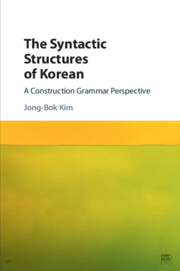Book contents
- Frontmatter
- Contents
- Acknowledgments
- Abbreviations
- 1 Theoretical foundations
- 2 Noun phrases
- 3 Case system
- 4 Auxiliary and complex predicate constructions
- 5 Gerund phrases and mixed categories
- 6 Verbal nouns and light verb constructions
- 7 Serial verb constructions
- 8 Negation and related phenomena
- 9 Coordination
- 10 Passive constructions
- 11 Wh-questions
- 12 Topic and focus constructions
- 13 Relative clause constructions
- 14 Honorification
- References
- Index
8 - Negation and related phenomena
Published online by Cambridge University Press: 05 July 2016
- Frontmatter
- Contents
- Acknowledgments
- Abbreviations
- 1 Theoretical foundations
- 2 Noun phrases
- 3 Case system
- 4 Auxiliary and complex predicate constructions
- 5 Gerund phrases and mixed categories
- 6 Verbal nouns and light verb constructions
- 7 Serial verb constructions
- 8 Negation and related phenomena
- 9 Coordination
- 10 Passive constructions
- 11 Wh-questions
- 12 Topic and focus constructions
- 13 Relative clause constructions
- 14 Honorification
- References
- Index
Summary
A common and productive method of expressing sentence negation in Korean is to introduce the negative marker an or a negative auxiliary anh-, which are called ‘short form’ (SFN) and ‘long form’ (LFN) negation, respectively. In this chapter, we show that treating the SFN as a prefix is more viable for various related phenomena such as ordering restrictions among adverbs, lexical blocking cases, plural copying, reduplication process, and the like. As for the LFN employing a negative auxiliary, this chapter shows that the Complex Predicate analysis can allow us to have a streamlined way of analyzing negation phenomena in Korean.
Short form and long form negation
The most typical way of expressing sentence negation in Korean is to introduce the negative marker an or mos in the preverbal position or the negative auxiliary anh- in the postverbal position:
(1) SFN (Short Form Negation)
a. Kim-un an ttena-ss-ta
Kim-TOP not leave-PST-DECL
‘Kim did not leave.’
b. Kim-un mos ttena-ss-ta
Kim-TOP not leave-PST-DECL
‘Kim could not leave.’
(2) LFN (Long Form Negation)
Kim-un ttena-ci anh-ass-ta
Kim-TOP leave-CONN not-PST-DECL
‘Kim did not leave.’
The SFN an or mos in (1) occurs in the preverbal position, while the LFN anh- follows the main verb marked with -ci, as given in (2). The different position of the negator distinguishes the two forms, though they are essentially synonymous.
Historically, the SFN an + V is developed from the adverbial negator ani and the LFN anh- from the combination of ani and ha- ‘do’. This historical development of phonological shortening in fact accompanies the recategorization of the negator from adverb to prefix for the SFN and to auxiliary for the LFN. The recategorization process can even be observed in childhood language uses (see Han and Park 1994, Hagstrom 2002, Han et al. 2007).
(3) a. an pesu tha
not bus ride
‘I do not take the bus.’
b. na mos pap hay
I not meal do
‘I can't cook.’
Such examples, misplacing the negator in front of the object, can often be observed in early childhood, but are eliminated in adult grammar.
There is much evidence, which we will consider in detail, that the two new forms are recategorized as prefix and auxiliary verb.
- Type
- Chapter
- Information
- The Syntactic Structures of KoreanA Construction Grammar Perspective, pp. 169 - 203Publisher: Cambridge University PressPrint publication year: 2016



